Passive Sonar Target Tracking Based on Deep Learning
Abstract
:1. Introduction
2. Passive Sonar Target Tracking System Model
2.1. Target State Equation
2.2. Target Measurement Equation
3. Passive Target Tracking Method Based on GRU–CKF
3.1. Time Update
3.2. Measurement Update
4. Simulation Results
5. Conclusions
Author Contributions
Funding
Institutional Review Board Statement
Informed Consent Statement
Data Availability Statement
Conflicts of Interest
References
- Wang, Y.-K.; Ding, Y. Data Fusion Simulation Model of Passive Sonar Target Wake Tracing Based on MGEKF. Torpedo Technol. 2010, 18, 35–40. [Google Scholar]
- Zhang, M.-T. Research on Fusion Algorithm of Multi Mobile Observations in Angle-Only Target Tracking. Master’s Thesis, Nanjing University, Nanjing, China, 2017. [Google Scholar]
- Guan, X.; He, Y.; Yi, X. Emulational Analysis on the Performance of Underwater Bearing-only Passive Target Tracking Using Two Arrays. J. Syst. Simul. 2003, 15, 1464–1466. [Google Scholar]
- Ito, M.; Tsujimichi, S.; Kosuge, Y. Tracking a three-dimensional moving target with distributed passive sensors using extended Kalman filter. Electron. Commun. Jpn. 2010, 84, 74–85. [Google Scholar] [CrossRef]
- Cao, Z.Q.; Meng, H. Bearing-only tracking algorithm for underwater passive target. Electron. Des. Eng. 2014, 22, 74–76. [Google Scholar]
- Xiao, B.-Q. Locating and Tracking of Target with Bearing-Only Small Maneuvering. Electron. Opt. Control 2017, 9, 27–30. [Google Scholar]
- Wang, B.-B.; Wu, P.L. Underwater bearing-only tracking based on square-root unscented Kalman filter smoothing algorithm. J. Chin. Inert. Technol. 2016, 24, 180–184. [Google Scholar]
- Xu, L.-X.; Liu, C.Y.; Yi, W.; Li, G.; Kong, L. A particle filter based track-before-detect procedure for towed passive array sonar system. In Proceedings of the 2017 IEEE Radar Conference (RadarConf), Seattle, WA, USA, 8–12 May 2017. [Google Scholar]
- Tiwari, R.K.; Radhakrishnan, R.; Bhaumik, S. Particle Filter for Underwater Passive Bearings-Only Target Tracking with Random Missing Measurements. In Proceedings of the 2018 17th European Control Conference (ECC), Limassol, Cyprus, 12–15 June 2018. [Google Scholar]
- Georgy, J.; Noureldin, A. Unconstrained underwater multi-target tracking in passive sonar systems using two-stage PF-based technique. Int. J. Syst. Sci. 2014, 45, 439–455. [Google Scholar] [CrossRef]
- Liu, Y.-L.; Feng, X.-X. Multiple Passive Sensors Target Tracking Algorithm Based on CKF. Comput. Simul. 2013, 30, 189–193. [Google Scholar]
- Dai, D.C.; Cai, Z.P.; Niu, C. Target Tracking Algorithm Based on Reduced Square-Root Cubature Kalman Filter. Electron. Opt. Control. 2015, 22, 11–14. [Google Scholar]
- Xu, J.; Xu, M.Z.; Zhou, X.-Y. The Bearing Only Target Tracking of UUV based on Cubature Kalman Filter with Noise Estimator. In Proceedings of the 36th Chinese Control Conference, Dalian, China, 26–28 July 2017. [Google Scholar]
- Hammel, S.; Aidala, V. Observability Requirements for Three-Dimensional Tracking via Angle Measurements. IEEE Trans. Aerosp. Electron. Syst. 2007, AES-21, 200–207. [Google Scholar] [CrossRef]
- Tao, S.; Ming, X. Bearings-Only Tracking Using Augmented Ensemble Kalman Filter. IEEE Trans. Control Syst. Technol. 2020, 20, 1009–1016. [Google Scholar]
- Geng, X.-M.; Suo, Y.J.; Yang, H. Algorithm for bearings-only Passive Localization Based on UKF. In Proceedings of the 2018 3rd International Workshop on Materials Engineering and Computer Sciences (IWMECS 2018), Jinan, China, 27 January 2018. [Google Scholar]
- Mehrjouyan, A.; Alfi, A. Robust adaptive unscented Kalman filter for bearings-only tracking in three dimensional case. Appl. Ocean Res. 2019, 87, 223–232. [Google Scholar] [CrossRef]
- Arasaratnam, I.; Haykin, S. Cubature Kalman Filters. IEEE Trans. Autom. Control 2009, 54, 1254–1269. [Google Scholar] [CrossRef] [Green Version]
- Wang, B.; Wen, Q.; Fan, S.-D. A Target Tracking Algorithm for UUV Based on Huber M-CKF. J. Unmanned Undersea Syst. 2020, 28, 39–45. [Google Scholar]
- Leong, P.H.; Arulampalam, S.; Lamahewa, T.A.; Abhayapala, T.D. A Gaussian-Sum Based Cubature Kalman Filter for Bearings-Only Tracking. Aerosp. Electron. Syst. IEEE Trans. 2013, 49, 1161–1176. [Google Scholar] [CrossRef]
- He, R.-K.; Chen, S.-X.; Wu, H.; Xu, H.; Chen, K.; Liu, J. Adaptive Covariance Feedback Cubature Kalman Filtering for Continuous-Discrete Bearings-Only Tracking System. IEEE Access 2019, 7, 2686–2694. [Google Scholar] [CrossRef]
- Zhang, A.; Shuida, B.A.; Fei, G.A.; Wenhao, B.I. A novel strong tracking cubature Kalman filter and its application in maneuvering target tracking. Chin. J. Aeronaut. 2019, 32, 99–112. [Google Scholar] [CrossRef]
- Wu, L.; Lu, F.-X.; Liu, Z. UKF algorithm and its applications to passive target tracking. Syst. Eng. Electron. 2005, 27, 49–51. [Google Scholar]
- Radhakrishnan, R.; Bhaumik, S.; Tomar, N.K. Continuous-discrete shifted Rayleigh filter for underwater passive bearings-only target tracking. IEEE J. Ocean Eng. 2019, 44, 492–501. [Google Scholar] [CrossRef]
- Su, J.; Li, Y.-A.; Chen, X.; Zhao, Z.-Y. Data Association Algorithm for Multi-target Tracking of Underwater Bearings-only Systems with Double Observation Stations. J. Unmanned Undersea Syst. 2018, 26, 115–121. [Google Scholar]
- Chen, Z.; Dai, W.-G.; Wang, Y.-C. Target course estimation for fixed monostatic passive sonar system. Chin. J. Sci. Instrum. 2017, 38, 320–327. [Google Scholar]
- Li, C.; Han, C.-Z.; Zhu, H.-Y.; Lou, Y. Target tracking algorithm for single passive sensor. Opto-Electron. Eng. 2006, 33, 5–9. [Google Scholar]
- Chen, H.; Li, C.; Lian, F. Track Initiation Algorithm for Two-dimensional Target Tracking Based on Bearing-only Measurements. Acta Aeronaut. Astronaut. Sin. 2009, 30, 692–697. [Google Scholar]
- Wang, R.; Feng, X.X.; Du, W.; Yan, X.-M. A Target Tracking Algorithm of Passive Sensor Normal Truncated Model. In Proceedings of the 2015 International Conference on Computer Science and Applications (CSA), Wuhan, China, 16 January 2017. [Google Scholar]
- Ou, Y.-C. Multi-target Tracking Based on Random Finite Set Theory for Passive Multi-Sensor Systems. Ph.D. Thesis, Xidian University, Xi’an, China, 2012. [Google Scholar]
- Gao, W.-J.; Li, Y.-A.; Chen, X.; Chen, Z.-G. Application of IMM to Underwater Maneuver Target Tracking. Torpedo Technol. 2015, 23, 196–201. [Google Scholar]
- Song, W.; Huang, Z.-Q. Inproved interacting multiple particle filter for passive multi-sensor. Ship Sci. Technol. 2017, 39, 145–149. [Google Scholar]
- He, Z.-L. The Research and Application of Maneuvering Target Tracking Method Based on Interactive Multiple Model. Master’s Thesis, Harbin Engineering University, Harbin, China, 2016. [Google Scholar]
- Yang, J.-L. Research on Algorithms of Target Tracking and Track Maintenance for Passive Multi-Sensor Systems. Ph.D. Thesis, Xidian University, Xi’an, China, 2012. [Google Scholar]
- Shentu, H.; Xue, A.-K.; Peng, D.L. A minimum geometrical entropy approach for variable structure multiple-model estimation. In Proceedings of the IET International Radar Conference 2015, Hangzhou, China, 21 April 2016. [Google Scholar]
- Dayu, H.; Jier, Q.; Shaofeng, W.; Yunze, C. A target tracking method based on tangential and normal acceleration variable-structure multiple model. In Proceedings of the 34th Chinese Control Conference, Hangzhou, China, 28 July 2015. [Google Scholar]
- Xu, L.-F.; Rong, L.I.X. Hybrid Grid Multiple-Model Estimation With Application to Maneuvering Target Tracking. IEEE Trans. Aerosp. Electron. Syst. 2016, 52, 122–136. [Google Scholar] [CrossRef]
- Wang, Z.-L.; Zhang, J.-Y.; Zhang, P.; Cheng, H.-B. An Improved Variable Structure Interacting Multiple Model Passive Tracking Algorithm. J. Air Force Eng. Univ. (Nat. Sci. Ed.) 2011, 12, 18–22. [Google Scholar]
- Zhao, Z.-Y.; Li, Y.-A.; Chen, X.; Su, J. Passive Tracking of Underwater Maneuvering Target Based on Double Observation Station. J. Unmanned Undersea Syst. 2018, 26, 40–45. [Google Scholar]
- Kim, J. Maneuvering target tracking of underwater autonomous vehicles based on bearing-only measurements assisted by inequality constraints. Ocean Eng. 2019, 189, 106404. [Google Scholar] [CrossRef]
- Katsikas, S.K.; Likothanassis, S.D.; Beligiannis, G.N.; Berkeris, K.G.; Fotakis, D.A. Genetically determined variable structure multiple model estimation. IEEE Trans. Signal Process. 2001, 49, 2253–2261. [Google Scholar] [CrossRef]
- Huang, X.Y.; Peng, D.L. A VSMM Algorithm Based on Unscented Digraph Switching for Maneuvering Target Tracking. Opto-Electron. Eng. 2010, 37, 30–34. [Google Scholar]
- Li, S.J.; Cao, F.; Lin, H.-S.; Wang, J.; Tang, J. Marine Maneuvering Target Tracking Based on Space-Based Bearing-Only Measurement. In Proceedings of the 2017 International Conference on Computer Science and Application Engineering (CSAE 2017), Shanghai, China, 22–24 July 2017. [Google Scholar]
- Feng, H.-L.; Guo, J.-L. Tracking Algorithm Based on Improved Interacting Multiple Model Particle Filter. J. Harbin Inst. Technol. 2019, 26, 47–53. [Google Scholar]
- Cai, M.; Liu, J. Maxout neurons for deep convolutional and LSTM neural networks in speech recognition. Speech Commun. 2016, 77, 53–64. [Google Scholar] [CrossRef]
- Han, M.; Chen, W.-Y.; Mogesa, D. Fast image captioning using LSTM. Clust. Comput. 2018, 22, 1–13. [Google Scholar] [CrossRef]
- Zheng, Y.; Chen, Q.-Q.; Zhang, Y. Deep learning and its new progress in object and behavior recognition. J. Image Graph. 2014, 19, 175–184. [Google Scholar]
- Köse, O.; Oktay, T. Hexarotor Longitudinal Flight Control with Deep Neural Network PID Algorithm and Morphing. European J. Sci. Technol. 2021, 27, 115–124. [Google Scholar]
- Köse, O.; Oktay, T. Quadrotor Flight System Design using Collective and Differential Morphing with SPSA and ANN. Int. J. Intell. Syst. Appl. Eng. 2021, 9, 159–164. [Google Scholar] [CrossRef]
- Milan, A.; Rezatofighi, S.H.; Dick, A.; Reid, I.; Schindler, K. Online Multi-target Tracking using Recurrent Neural Networks. arXiv 2016, arXiv:1604.03635. [Google Scholar]
- Gao, C.; Liu, H.; Zhou, S.; Su, H.; Chen, B.; Yan, J.; Yin, K. Maneuvering Target Tracking with Recurrent Neural Networks for Radar Application. In Proceedings of the 2018 International Conference on Radar (RADAR), Brisbane, QLD, Australia, 27–31 August 2018. [Google Scholar]
- Hochreiter, S.; Schmidhuber, J. Long Short-Term Memory. Neural Comput. 1997, 9, 1735–1780. [Google Scholar] [CrossRef]
- Kim, H.I.; Park, R.H. Residual LSTM Attention Network for Object Tracking. IEEE Signal Process. Lett. 2018, 25, 1029–1033. [Google Scholar] [CrossRef]
- Gao, C.; Yan, J.; Zhou, S.; Varshney, P.K.; Liu, H. Long short-term memory-based deep recurrent neural networks for target tracking. Inf. Sci. 2019, 502, 279–296. [Google Scholar] [CrossRef]
- Chung, J.; Gulcehre, C.; Cho, K.; Bengio, Y. Empirical Evaluation of Gated Recurrent Neural Networks on Sequence Modeling. arXiv 2014, arXiv:1412.3555. [Google Scholar]
- Hu, C.; Ou, T.; Zhu, Y.; Zhu, L. GRU-Type LARC Strategy for Precision Motion Control with Accurate Tracking Error Prediction. IEEE Trans. Ind. Electron. 2021, 68, 812–820. [Google Scholar] [CrossRef]
- Li, D.G.; Wu, Y.Q.; Zhao, J.-M. Novel Hybrid Algorithm of Improved CKF and GRU for GPS/INS. IEEE Access 2020, 8, 202836–202847. [Google Scholar] [CrossRef]
- Liu, C.-H.; Liang, Y.; Zhou, D.-H. A Survey of Passive Target Tracking. Mod. Radar 2003, 25, 5–10. [Google Scholar]


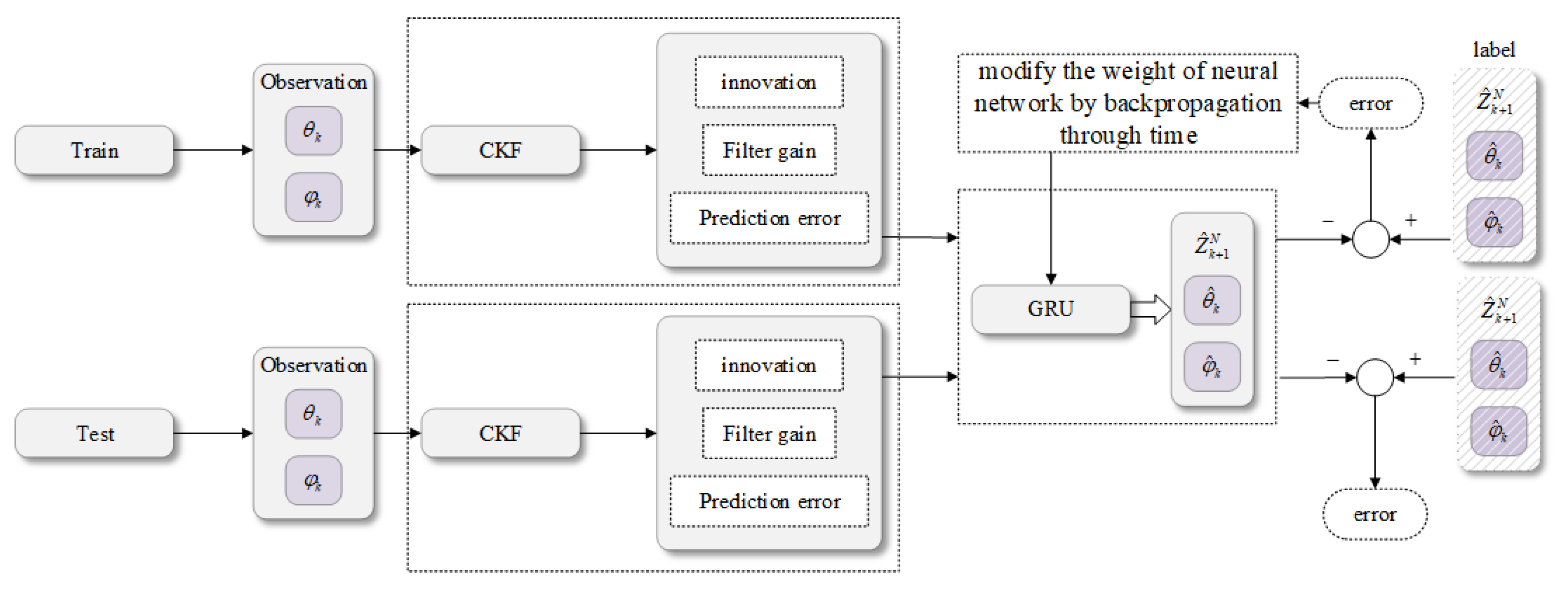
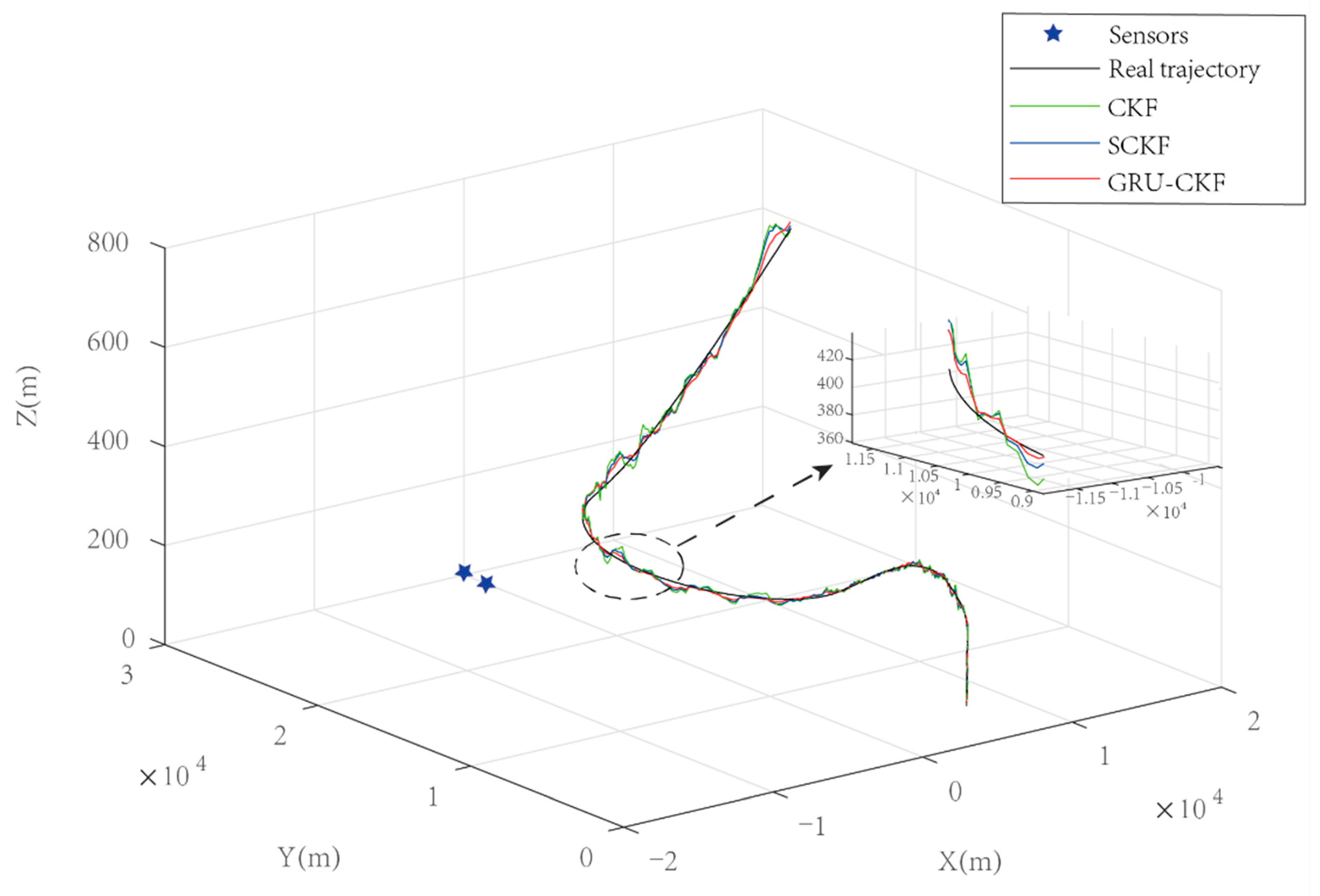
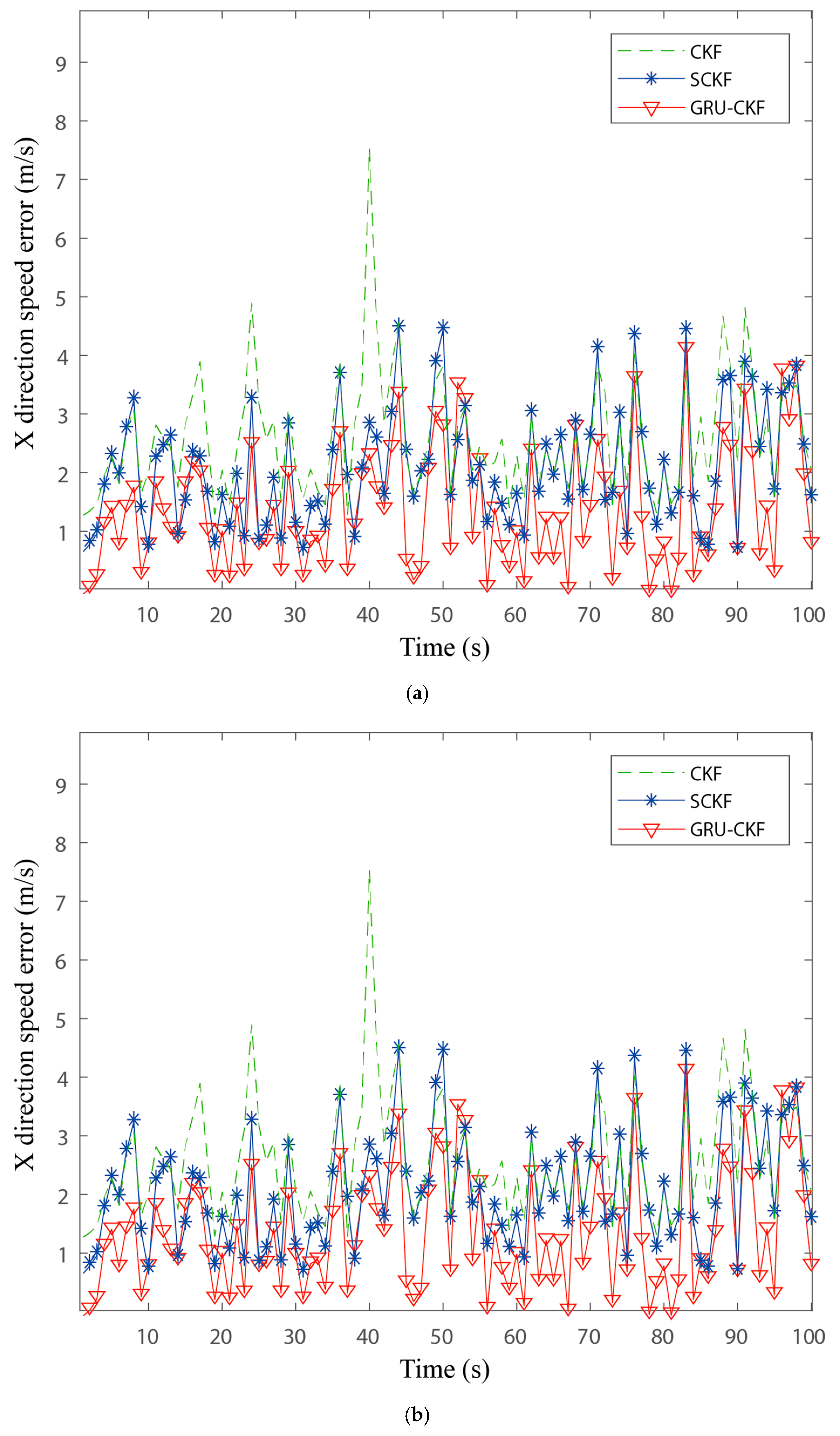
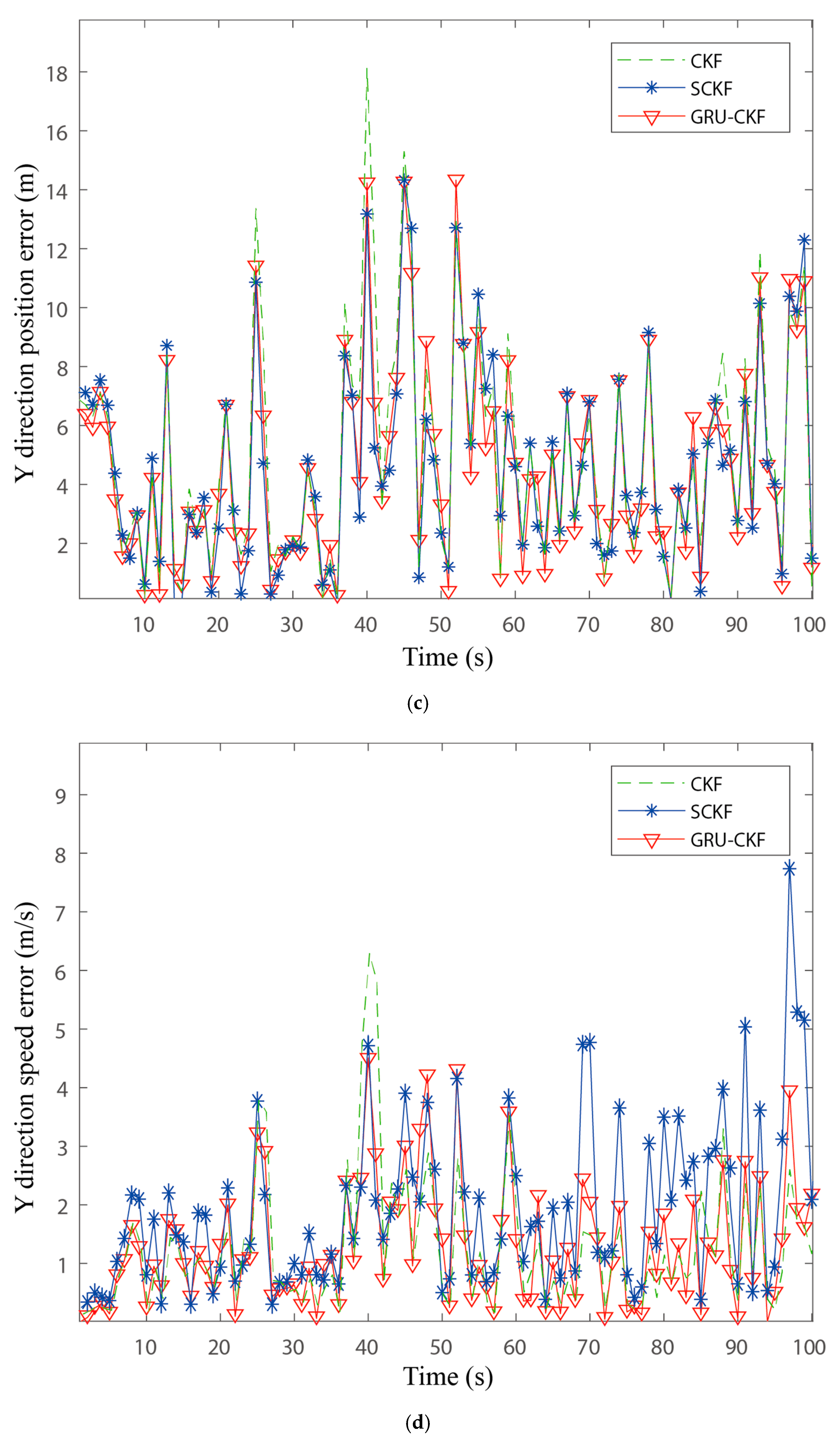
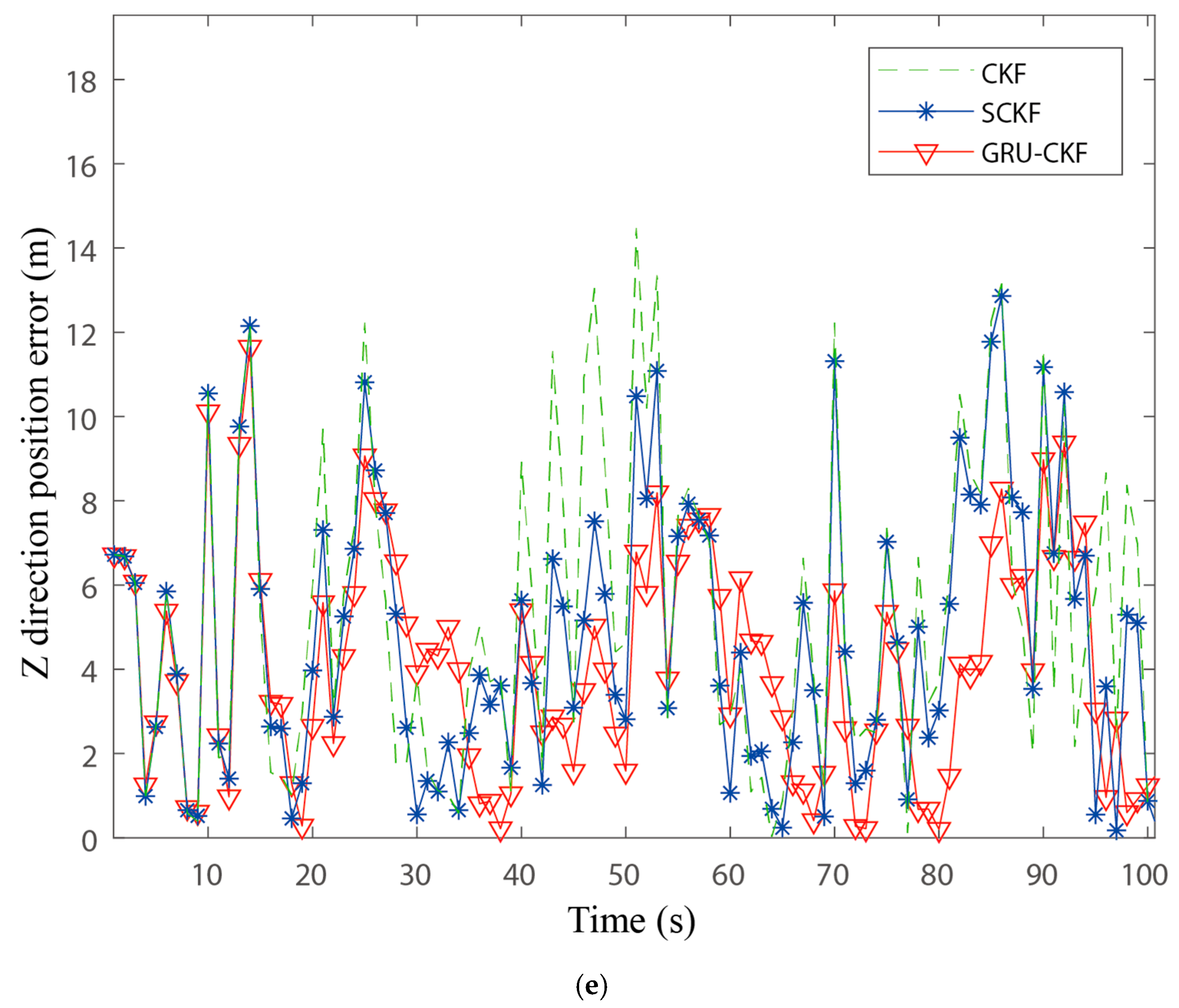
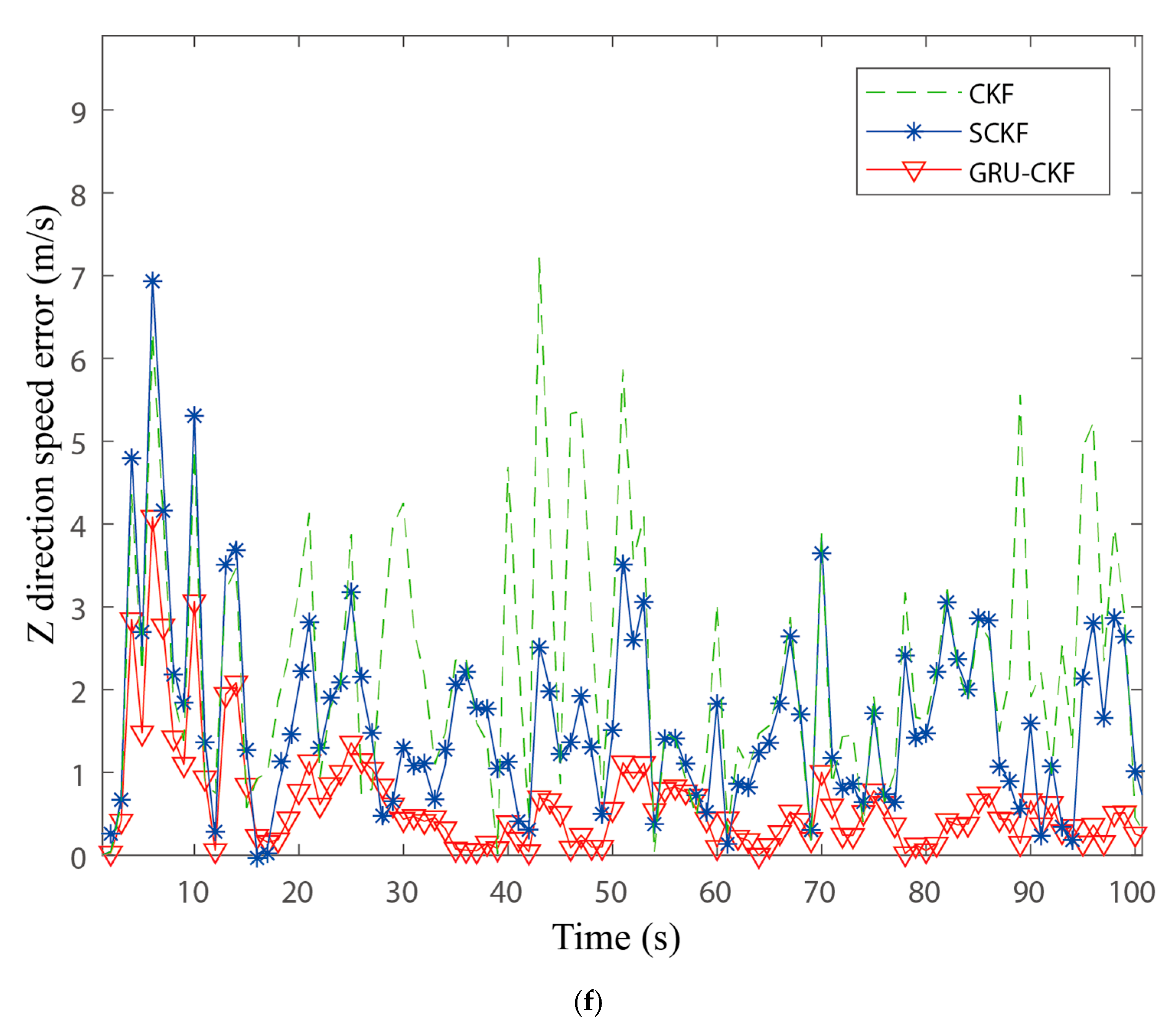
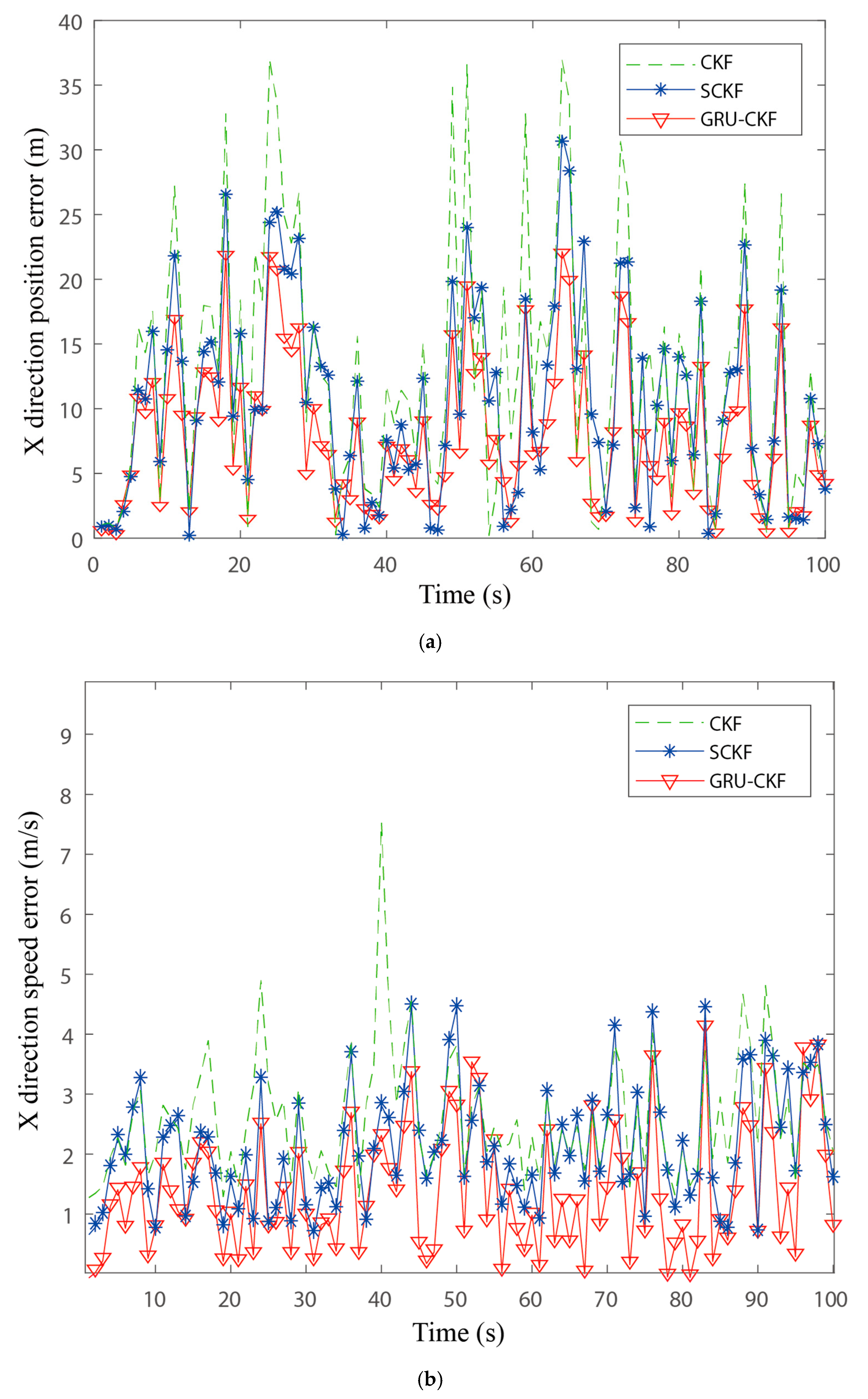
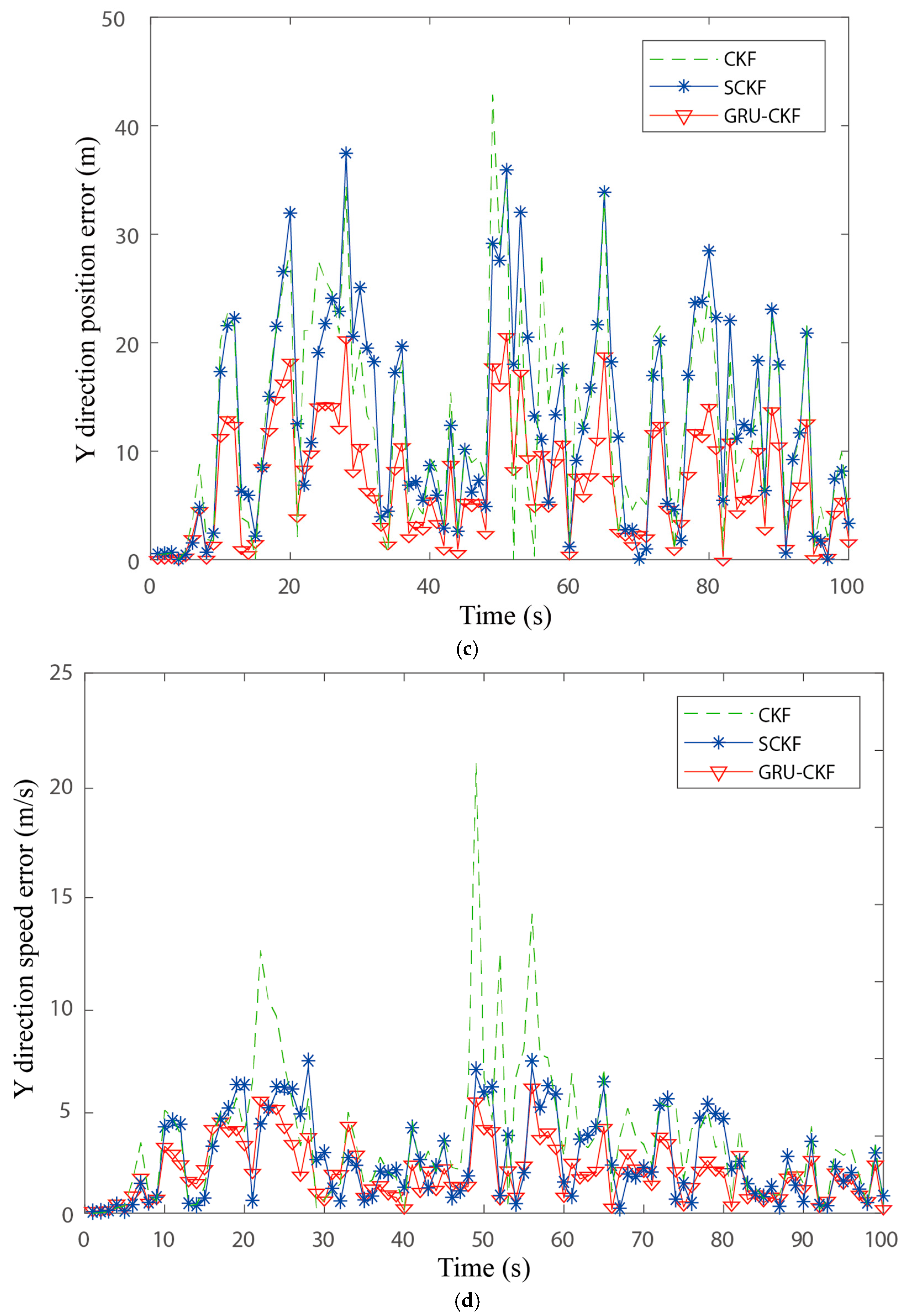


| Time/s | Motion Model | Motion Parameters |
|---|---|---|
| 0~50 | CA | The accelerations in X, Y, and Z directions are set to: 0.5 m/s2, 0.4 m/s2, 0 m/s2 |
| 51~90 | CV | The velocities in X, Y, and Z directions are set to: 25 m/s, −26 m/s, −15 m/s |
| 91~170 | CT | The angular velocity is set to: |
| 171~230 | CA | The accelerations in X, Y, and Z directions are set to: −2 m/s2, −0.5 m/s2, −0.2 m/s2 |
| 231~320 | CT | The angular velocity is set to: |
| 321~400 | CA | The accelerations in X, Y, and Z directions are set to: 2 m/s2, 1 m/s2, 0 m/s2 |
| Algorithm | ||||||
|---|---|---|---|---|---|---|
| CKF | 11.6104 | 11.3828 | 12.3102 | 26.3347 | 27.3653 | 15.0960 |
| SCKF | 9.4278 | 9.9950 | 9.9217 | 20.4412 | 21.2506 | 10.6005 |
| GRU–CKF | 6.6508 | 8.3904 | 7.2551 | 6.9011 | 8.6089 | 7.6733 |
Publisher’s Note: MDPI stays neutral with regard to jurisdictional claims in published maps and institutional affiliations. |
© 2022 by the authors. Licensee MDPI, Basel, Switzerland. This article is an open access article distributed under the terms and conditions of the Creative Commons Attribution (CC BY) license (https://creativecommons.org/licenses/by/4.0/).
Share and Cite
Wang, Y.; Wang, H.; Li, Q.; Xiao, Y.; Ban, X. Passive Sonar Target Tracking Based on Deep Learning. J. Mar. Sci. Eng. 2022, 10, 181. https://doi.org/10.3390/jmse10020181
Wang Y, Wang H, Li Q, Xiao Y, Ban X. Passive Sonar Target Tracking Based on Deep Learning. Journal of Marine Science and Engineering. 2022; 10(2):181. https://doi.org/10.3390/jmse10020181
Chicago/Turabian StyleWang, Ying, Hongjian Wang, Qing Li, Yao Xiao, and Xicheng Ban. 2022. "Passive Sonar Target Tracking Based on Deep Learning" Journal of Marine Science and Engineering 10, no. 2: 181. https://doi.org/10.3390/jmse10020181
APA StyleWang, Y., Wang, H., Li, Q., Xiao, Y., & Ban, X. (2022). Passive Sonar Target Tracking Based on Deep Learning. Journal of Marine Science and Engineering, 10(2), 181. https://doi.org/10.3390/jmse10020181






